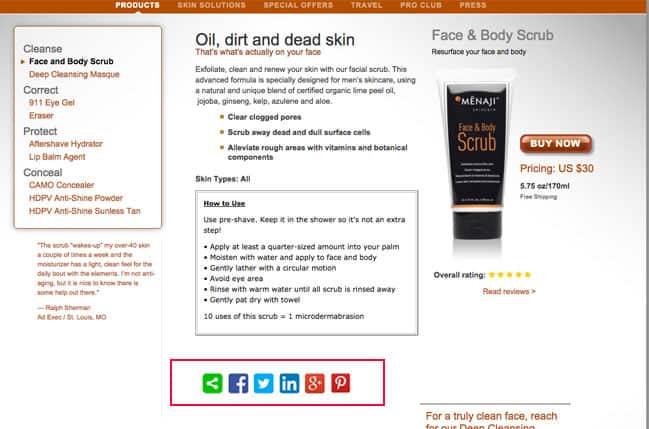
Contrary to popular belief, removing social sharing tools from ecommerce product detail pages has proven to increase conversion rates. Shocking? It won’t be after reading this.
For many designers and site owners, social sharing tools are on the list of must-have features included in every website build. Unfortunately, in most cases they are distracting and drive little or no interaction.
Ecommerce websites in particular require user experiences that keep shoppers focused on moving through the checkout process and making purchases. Anything that distracts them or detracts from the end goal should be eliminated.
Take a product detail page, for example. Would you rather have a customer trying to decide which social platform to share your product on, or clicking the “Add To Cart” button? I’d say the unanimous answer is the later.
In the below example, there are 6 sharing icons below the product details. One of the icons opens a pop-up window that repeats the Facebook, Twitter and LinkedIn icons, and looks overly confusing.
Most importantly, the placement and visual styling of the sharing tools take prominence over the “Buy Now” button, and the page content for that matter. The site design consists of earth tones while the buttons provide the only burst of color, which draws the eye immediately to them. This is not good!
Web design as a whole has transitioned to the less-is-more philosophy, as studies by consumer psychologists and marketing experts tell us that too much choice often results in inaction. This means you should include only elements that contribute to driving sales. Everything else is just noise.
Other reasons to exclude social media sharing icons from your ecommerce product pages:
– Content with zero shares doesn’t look very impressive, and won’t bode well for convincing users that you’re a popular or desirable brand.
– They require users to perform additional actions like opening modal windows, signing into their accounts and checking to see whether or not the share was posted.
– They can often be buggy, and site glitches can lead to high abandonment rates.
Let`s Get
In Touch
Contact us today for a free consultation
and cost estimate for
your project.
We work with companies in all
industries, big or small.
Give Us a Call: 786-529-6039
Services
©2024 FUZE DIGITAL INC. Ignite Your Brand™ | privacy






